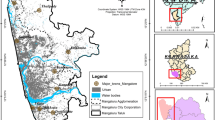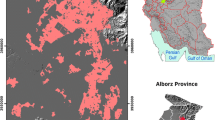Abstract
The middle basin of Heihe River has witnessed rapid urban growth and excessive agricultural activities during the last two decades, mainly because of its economic development and increasing population pressure. In this study, we aimed to understand the growth dynamics of the region, to forecast its future expansion, and to provide a basis for regional management. We calibrated and validated a SLEUTH model with historical data derived from different sources, which comprised remotely sensed and strategic planning data records from 1995, 2000, 2005, and 2009. Three scenarios based on local regional ecological planning were designed to simulate the spatial pattern of urban growth in different conditions. The first scenario allowed urban expansion without any additional managed growth limitations and the continuation of the actual historical trend. The second scenario was limited based on environmental considerations and managed growth was assumed with moderate protection. The third scenario simulated managed growth with strict protection on wetland reserves and productive agricultural areas in the study area. We consider that the results of these models of growth in the study area obtained under different scenarios are of great potential use to city managers and stakeholders. We also suggest that scale sensitivity and spatial accuracy are among the factors that must be considered in practical applications. We urge future researchers to build on the present study to produce models for similar regions in northwest China.








Similar content being viewed by others
References
Ahern J (2013) Urban landscape sustainability and resilience: the promise and challenges of integrating ecology with urban planning and design. Landscape Ecol 28:1203–1212
Batty M (2008) The size, scale and shape of cities. Science 319:769–770
Batty M, Torrens PM (2005) Modeling and prediction in a complex world. Futures 37(7):745–766
Batty M, Xie Y (1994) From cells to cities. Environ Plan 21:531–548
Candau JT (2002) Temporal calibration sensitivity of the SLEUTH urban growth model. Dissertation, University of California, Santa Barbara
Chaudhuri G, Clarke KC (2013) The SLEUTH land use change model: a review. Int J Environ Resour Res 1(1):88–104
Clarke KC (2008) A decade of cellular urban modeling with SLEUTH: unresolved issues and problems, chapter 3. In: Brail RK (ed) Planning support systems for cities and regions. Lincoln Institute of Land Policy, Cambridge, pp 47–60
Clarke KC, Gaydos LJ (1998) Loose–coupling a cellular automaton model and GIS: long-term urban growth prediction for San Francisco and Washington/Baltimore. Int J Geogr Inf Sci 12:699–714
Clarke KC, Hoppen S, Gaydos L (1997) A self-modifying cellular automaton model of historical urbanization in the San Francisco Bay area. Environ Plan B 24:247–261
Clarke KC, Gazulis N, Dietzel CK, Goldstein NC (2007) A decade of SLEUTHing: lessons learned from applications of a cellular automaton land use change model, chapter 16. In: Fisher P (ed) Classics from IJGIS. Twenty Years of the International Journal of Geographical Information Systems and Science. Taylor and Francis/CRC, Boca Raton, pp 413–425
Congalton R, Green K (2009) Assessing the accuracy of remotely sensed data: principles and practices, 2nd edn. CRC/Taylor & Francis, Boca Raton, p 183
Dietzel C, Clarke KC (2007) Toward optimal calibration of the SLEUTH land use change model. Trans GIS 11(1):29–45
Feng Q, Cheng GD (2001) Towards sustainable development of the environmentally degraded River Heihe Basin, China. Hydrol Sci J 46:647–658
Gazulis N, Clarke KC (2006) Exploring the DNA of our regions: classification of outputs from the SLEUTH model. Cellular automata. Springer, Berlin, pp 462–471
Goldstein NC, Candau JT, Clarke KC (2004) Approaches to simulating the “March of Bricks and Mortar” computers. Environ Urban Syst 28:125–147
Grimm N, Grove JM, Pickett STA, Redman CL (2000) Integrated approaches to long-term studies of urban ecological systems. Bioscience 50(7):571–584
Guan QF, Clarke KC (2010) A general-purpose parallel raster processing programming library test application using a geographic cellular automata model. Int J Geogr Inf Sci 24(5):695–722
Herold M, Goldstein NC, Clarke KC (2003) The spatio-temporal form of urban growth: measurement, analysis and modeling. Remote Sens Environ 86:286–302
Jantz CJ, Goetz SJ (2005) Analysis of scale dependencies in an urban land use change model. Int J Geogr Inf Sci 19(2):217–241
Jantz CJ, Goetz SJ, Smith AJ, Shelly M (2003) Using the SLEUTH Urban growth model to simulate the impacts of future policy scenarios on land use in the Baltimore–Washington metropolitan area. Environ Plan B 31:251–271
Jantz CJ, Goetz SJ, Donato D, Claggett P (2010) Designing and implementing a regional urban modeling system using the SLEUTH cellular urban model. Comput Environ Urban Syst 34:1–16
Landis J, Zhang M (1998) The second generation of the California urban futures model. Part 1: model logic and theory. Environ Plan 30:657–666
Leao S, Bishop I, Evans D (2004) Spatial-temporal model for demand allocation of waste landfills in growing urban regions. Comput Environ Urban Syst 28:353–385
Li X, Liu X (2006) An extended cellular automaton using case-based reasoning for simulating urban development in a large complex region. Int J Geogr Inf Sci 20:1109–1136
Li X, Yeh AG (2000) Modeling sustainable urban development by the integration of constrained cellular automata and GIS. Int J Geogr Inf Sci 14:131–152
Matthews R, Gilbert NG, Roach A, Polhill JG, Gotts NM (2007) Agent–based land use models: a review of applications. Landscape Ecol 22:1447–1459
Oguz H, Klein A, Srinivasan R (2007) Using the sleuth urban growth model to simulate the impacts of future policy scenarios on urban land use in the Houston–Galveston–Brazoria CMSA. Res J Soc Sci 2:72–82
Onsted J, Clarke KC (2011) Using Cellular automata to forecast enrollment in differential assessment programs. Environ Plan B 38(5):829–849
Onsted J, Clarke KC (2012) The inclusion of differentially assessed lands in urban growth model calibration: a comparison of two approaches using SLEUTH. Int J Geogr Inf Sci 26(5):881–898
Pickett STA, Cadenasso ML, Grove JM, Nilon CH, Pouyat RV, Zipperer WC, Costanza R (2001) Urban ecological systems: linking terrestrial ecological, physical, and socioeconomic components of metropolitan areas. Annu Rev Ecol Syst 32:127–157
Pontius RG, Millones M (2011) Death to Kappa: birth of quantity disagreement and allocation disagreement for accuracy assessment. Int J Remote Sens 15:4407–4429
Pontius RG, Schneider LC (2001) Land-cover change model validation by an ROC method for the Ipswich watershed, Massachusetts, USA. Agric Ecosyst Environ 85(1–3):239–248
Pontius RG, Huffaker D, Denman K (2004) Useful techniques of validation for spatially explicit land-change models. Ecol Model 179(4):445–461
Pontius RG, Boersma W, Castella JC, Clarke CK, Nijs T, Dietzel C, Duan Z, Fotsing E, Goldstein N, Kok K, Koomen K, Lippitt CD, McConnell W, Sood AM, Pijanowski B, Pithadia S, Sweeney S, Trung TN, Veldkamp AT, Verburg PH (2008) Comparing the input, output, and validation maps for several models of land change. Ann Reg Sci 42:11–47
Reza R, Abdolrassoul SM, Nematolah K, Ali AD, Afshin D (2009) Simulating urban growth in Mashad City, Iran through the SLEUTH model (UGM). Cities 26:19–26
Seto KC, Fragkias M (2005) Quantifying spatiotemporal patterns of urban land-use change in four cities of China with time series landscape metrics. Landscape Ecol 20(7):871–888
Seto KC, Kaufmann RK, Woodcock CE (2000) Landsat reveals China’s farmland reserves, but they’re vanishing fast. Nature 406:121
Silva EA, Clarke KC (2001) Calibration of the SLEUTH urban growth model for Lisbon and Porto, Portugal. Comput Environ Urban Syst 26(6):525–552
Silva EA, Clarke KC (2002) Calibration of the SLEUTH urban growth model for Lisbon and Porto, Portugal Computers. Environ Urban Syst 26:525–552
Silva EA, Clarke KC (2005) Complexity, emergence and cellular urban models: lessons learned from applying sleuth to two Portuguese metropolitan areas. Eur Plan Stud 13(1):93–116
Tian L, Chen JQ, Shi XY (2014) Coupled dynamics of urban landscape pattern and socioeconomic drivers in Shenzhen, China. Landscape Ecol 29(4):715–727
Verburg PH, Veldkamp A (2005) Introduction to the special issue on spatial modeling to explore land use dynamics. Int J Geogr Inf Sci 19(2):99–102
Wang G, Liu J, Kubota J, Chen L (2007) Effects of land-use changes on hydrological processes in the middle basin of the Heihe River, northwest China. Hydrol Process 21(10):1370–1382
Wolfram S (1984) Cellular automata as models of complexity. Nature 311:419–424
Xiang WN, Clarke KC (2003) The use of scenarios in land use planning. Environ Plan 30:885–909
Acknowledgments
This study was supported by the National Basic Research Program of China (Contract No. 91025002 and 91125019). The authors would like to thank editors and anonymous reviewers for their valuable comments and suggestions to improve this paper.
Author information
Authors and Affiliations
Corresponding author
Rights and permissions
About this article
Cite this article
Liang, Y., Liu, L. Modeling urban growth in the middle basin of the Heihe River, northwest China. Landscape Ecol 29, 1725–1739 (2014). https://doi.org/10.1007/s10980-014-0089-9
Received:
Accepted:
Published:
Issue Date:
DOI: https://doi.org/10.1007/s10980-014-0089-9




